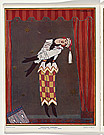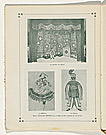Petrouchka [Petrushka]
Burlesque in four scenes
- Producer: Les Ballets Russes de Serge Diaghilev
- Premiere: 13 June 1911, Théâtre du Châtelet, Paris
- Costume design: Alexandre Benois
- Costumier: Ivan Caffi and Vorobier
- Scenery design: Alexandre Benois
- Music: Igor Stravinsky
- Choreography: Michel Fokine
- Libretto: Igor Stravinsky
- Main characters: Petrouchka, the Ballerina, the Moor, the Charlatan, Street dancers, the Chief nursemaid, Nursemaids, Chief coachman, coachmen, masqueraders, peasants
The ballet is set in 1830, just before Lent during the annual Butter Week Festival, in Admiralty Square, St Petersburg. An old and dastardly showman, the Charlatan, demonstrates his lifelike puppets—sad and ugly Petrouchka, a rag doll; the beautiful but vapid Ballerina and the Moor, a brutish exhibitionist—to an eager crowd of boulevardiers, colourful peasantry and other performers. Between their performances the puppets are imprisoned in rooms in the Charlatan’s booth. Both Petrouchka and the Moor are in love with the Ballerina. Petrouchka’s advances towards her provoke the Moor to attack and kill him with a scimitar. This tragic scenario unfolds in front of the shocked and horrified spectators. The Charlatan hastens to disprove the events by demonstrating that Petrouchka is only a doll filled with sawdust. However, after the crowd leaves the square the ghost of the marionette appears above the booth, menacing the horrified Charlatan.
Petrouchka reflects a brilliant fusion of the creativity of Stravinsky, Benois and Nijinsky. Developed from Stravinsky’s 1910 piano work, Petrouchka’s cry, the ballet reflected the interest of the miriskusniki in street theatre, mime, puppet shows (balagani), and the traditions of commedia dell’arte. The use of puppets, particularly in the implicit racism of the depiction of the black Moor and the vapidity of the Ballerina, allowed Stravinsky and Fokine to exploit racial stereotypes within the changing cultural and ethnic landscape of nineteenth-century Russia. In the role of the lifeless Petrouchka, animated and annihilated by love, Nijinsky gave his most memorable and accomplished performance, not least because his grotesque characterisation of the controlled and brutalised puppet was deliberately at odds with his usual feline grace on stage. Benois placed his characters in the evocative setting of Maslenitsa, the St Petersburg pre-Lenten Butter Week festivities that he remembered so fondly from his youth. He also moved on from his predilection for eighteenth-century styles to an adventurous exploration of the colour territory that had been mapped by Bakst, particularly in his sets for the Moor’s and Petrouchka’s rooms with their over-scaled and garish decoration designed to diminish the puppets. Petrouchka’s costume is in the stylistic convention of Pierrot, with a white top, a ruff and vandyke braid edging over garish pink and yellow chequered trousers, blue boots, a black and white hat and black mittens.



![Adrian FEINT | not titled [man in clown-like costume and red mittens in ballet 'Petrouchka]. |](images/sml/57944.jpg)









